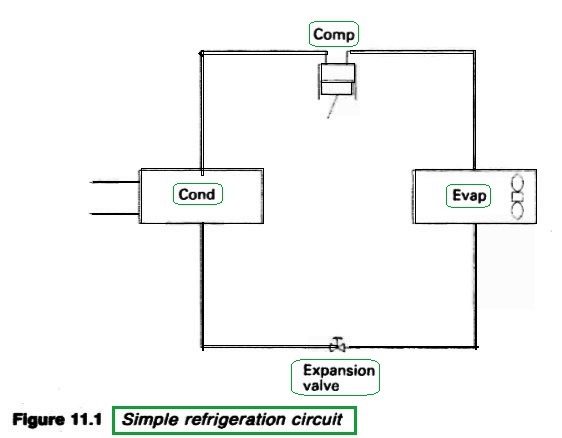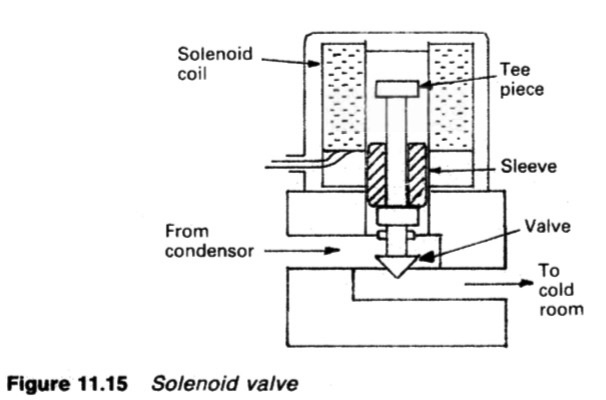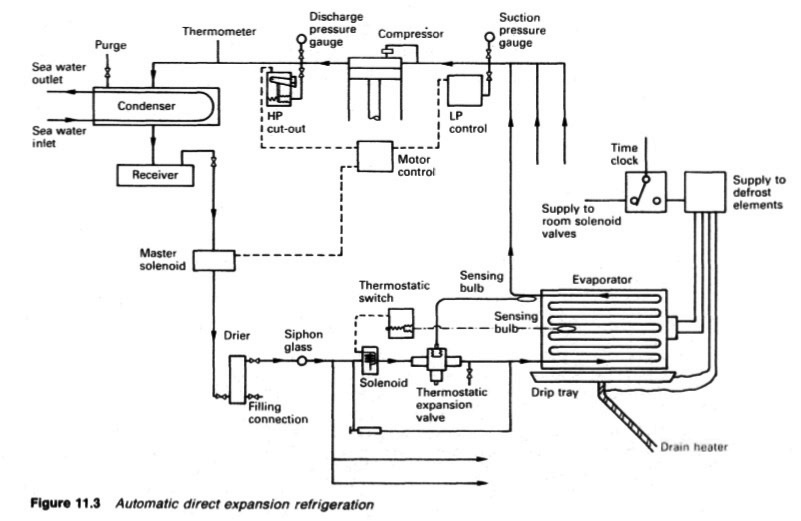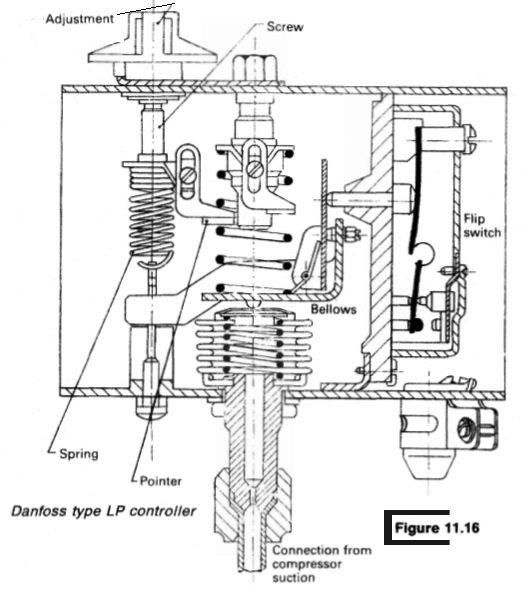
Home page||Refrigeration system||
Room temperature controller in a refrigerated space
The principles of refrigeration,
briefly stated below, are the same for each of the applications.
The main consideration with a ship built solely for the carriage of refrigerated
cargo, is the high value of the produce which could be lost in the event of
serious failure of the refrigerating machinery. A second very important consideration
is that the produce should reach the consumer in good condition.
The purpose of refrigeration in the carriage of perishable foodstuffs, is to
prevent or check spoilage, the more important causes of which are:-
1 excessive growth of micro-organisms, bacterial and fungal;
-
2 changes due to oxidation, giving poor appearance and flavours;
-
3 enzymatic or fermentive processes, causing rancidity;
-
4 drying out (dessication);
-
5 The metabolism and ripening processes of fruit and vegetables.
The perishable foodstuffs carried as refrigerated cargo or as stores on ships can
be categorized as dead produce such as meat and fish or as live produce such as
fruit and vegetables. The dead cargoes tend to be carried frozen, an exception
being made for meat on voyages of moderate length which may be carried
chilled.
A 10% carbon dioxide level has been found beneficial in cargo spaces
for chilled meat. Fruit and vegetables are regarded as live cargoes until
consumed, because they continue to ripen albeit slowly under refrigerated
conditions. Fruit and vegetables continue a separate existence during which
oxygen is absorbed and CO2 is given off, with the generation of heat. The rate
of respiration varies with the type of fruit and also directly with the
temperature. Apples can produce CO2 at the rate of 0.06 mVtonne/day at
carrying temperature and evolve heat at a rate of some 12 W/tonne/h in the
process. Each commodity has its own specific storage condition for the best
result.

Figure : Simple refrigeration circuit
Room temperature control
The temperature of the refrigerated spaces with a direct expansion system (Figure 11.3) is controlled between limits through a thermostatic switch and a solenoid valve which is either fully open to permit flow of refrigerant to the room evaporator, or closed to shut off flow. The solenoid valve (Figure 11.15) is opened when the sleeve moving upwards due to the magnetic coil hits the valve spindle tee piece and taps the valve open.
It closes when the coil is de-energized and the sleeve drops and taps the valve shut. Loss of power therefore will cause the valve to shut and a thermostatic switch is used to operate it through simple on/off switching. The thermostatic switch contains a bellows which expands and contracts under the influence of fluid in a capillary and sensing bulb attached to it. The bulb is filled with freon or other fluid which expands and contracts with the temperature change in the space in which it is situated.
As the temperature is brought down to the required level, contraction of the fluid deflates the bellows. The switch opens and the solenoid is de-energized and closes. A temperature rise operates the switch to energize the solenoid which opens to allow refrigerant through to the evaporator again. The switch is similar in principle to the high pressure cutout and low pressure controller.

Figure 11.15 : Refrigeration-solenoid-valve

Figure 11.3 : Automatic direct expansion refrigeration
Low pressure controller
The low pressure control (Figure 11.3) stops the compressor when low suction pressure indicates closure of all cold compartment solenoids. When the pressure in the compressor suction rises again due to one or more solenoids opening, the low pressure control restarts the compressor.

figure 11.16 : Danfoss type LP controller
The controller shown (Figure 11.16) is of the Danfoss type operated through a bellows which monitors pressure in the compressor suction. A pressure differential between cut out and cut in settings is necessary to avoid hunting. The push pin operates the switch through a contact which is flipped open or closed through a coiled spring plate. With the contacts open the spring is coiled as shown. Outward movement of the pin compresses the spring and this then flips the contact to close the compressor starting circuit.
Summarized below various refrigeration system components, working process and maintenance guideline:
- Automatic direct expansion refrigeration- vapour compression
The basic components of any refrigeration system (Figure 11.1) working on the
vapour compression cycle, are the compressor, condenser, expansion valve,
evaporator and the refrigerant fluid which is alternately vaporized and liquefied
during the refrigeration cycle. The temperature at which a fluid boils or
condenses, is known as the saturation temperature and varies with pressure....more
-
Choice of refrigerants
Theoretically, almost any liquid can be used as a refrigerant if its pressure/temperature relationship is suitable for the conditions. Although no perfect refrigerant is known, there are certain factors which determine a refrigerant's desirability for a particular duty and the one selected should possess as many as possible of the following
characteristics.....more
-
Refrigeration systems - Chamber cooling arrangements
To avoid having an extended refrigeration circuit for cargo cooling, a brine system can be used. The brine is cooled by the evaporator and in turn cools grids or batteries. Grids provide cooling which relies on convection and conduction but air circulated through brine batteries provides a positive through cooling effect.
.....more
-
Refrigeration system components
Marine condensers are generally of the shell and tube type, designed for high pressures. There may a few coil-in-casing or other types still in use. The coolant passes through the tubes with refrigerant condensing on the outside......more
-
Refrigeration system compressors
Refrigeration compressors are usually either reciprocating, or of the rotary
screw displacement type. Centrifugal and rotary vane compressors have also
been used.....more
-
Refrigeration systems expansion valves
The expansion valve is the regulator through which the refrigerant passes from the high pressure side of the system to the low pressure side. The pressure drop causes the evaporating temperature of the refrigerant to fall below that of the evaporator. .....more
- Monitoring instruments,CO2 measurement & Heat leakage and insulation test
All necessary cargo temperature readings are obtained on modern reefers and container ships on a data logger which makes an automatic record. The temperatures and pressures relating to refrigerant gas and liquid, cooling water, brine and the ambient are also required. Most of these are obtained from direct reading instruments.
.....more
- Marine condenser assembly
The temperature of the refrigerated spaces with a direct expansion system is controlled between limits through a thermostatic switch and a solenoid valve which is either fully open to permit flow of refrigerant to the room evaporator, or closed to shut off flow. The solenoid valve is opened when the sleeve moving upwards due to the magnetic coil hits the valve spindle tee piece and taps the valve open.....more
- Comparison between refrigerants R717 ammonia & R744 carbon dioxide
The ammonia used for refrigeration systems based on the use of a compressor,
condenser, expansion valve and an evaporator (Figure 11.2) is dry (anhydrous)
in that there is no water in solution with it. It has the chemical formula NH3 but
as a refrigerant, it is coded with the number R717....more
-
Container cooling system
The air is cooled either by brine or direct expansion batteries and the containers are arranged so that one cooler can maintain a stack of containers at a given temperature. The temperature of the return air duct for each container is monitored.....more
Home page||Cooling ||Machinery||Services ||Valves ||Pumps ||Auxiliary Power ||Propeller shaft ||Steering gears ||Ship stabilizers||Refrigeration||Air conditioning ||Deck machinery||Fire protection||Ship design
||Home ||
General Cargo Ship.com provide information on cargo ships various machinery systems -handling procedures, on board safety measures and some basic knowledge of cargo ships that might be useful for people working on board and those who working in the terminal. For any remarks please
Contact us
Copyright © 2010-2016 General Cargo Ship.com All rights reserved.
Terms and conditions of use
Read our privacy policy|| Home page||



